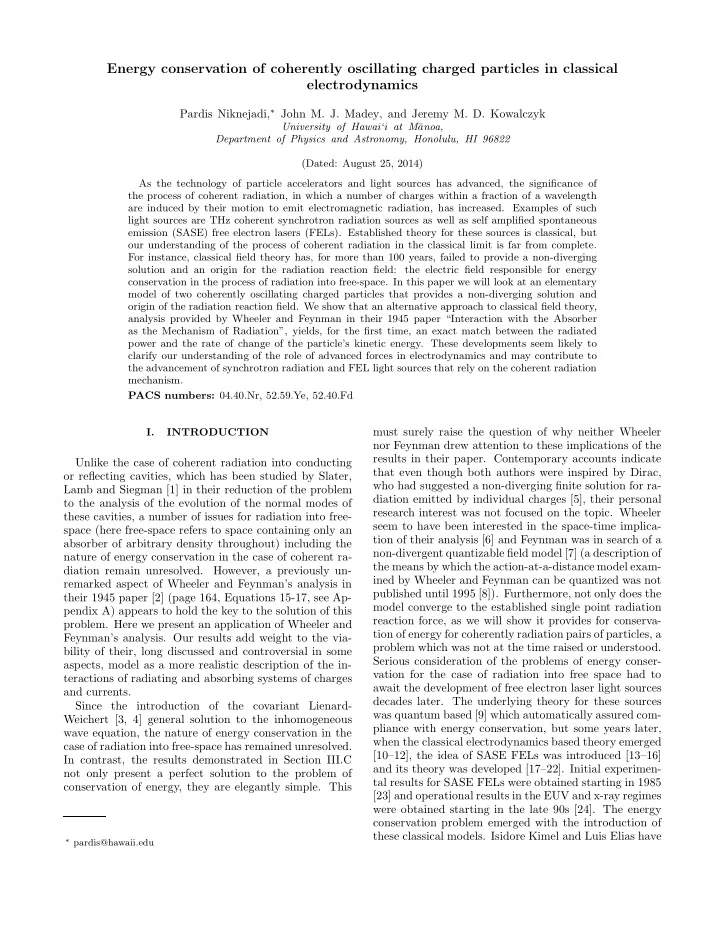

Energy conservation of coherently oscillating charged particles in classical electrodynamics Pardis Niknejadi, ∗ John M. J. Madey, and Jeremy M. D. Kowalczyk University of Hawai‘i at M ¯ a noa, Department of Physics and Astronomy, Honolulu, HI 96822 (Dated: August 25, 2014) As the technology of particle accelerators and light sources has advanced, the significance of the process of coherent radiation, in which a number of charges within a fraction of a wavelength are induced by their motion to emit electromagnetic radiation, has increased. Examples of such light sources are THz coherent synchrotron radiation sources as well as self amplified spontaneous N emission (SASE) free electron lasers (FELs). Established theory for these sources is classical, but our understanding of the process of coherent radiation in the classical limit is far from complete. O For instance, classical field theory has, for more than 100 years, failed to provide a non-diverging Y solution and an origin for the radiation reaction field: the electric field responsible for energy conservation in the process of radiation into free-space. In this paper we will look at an elementary I P model of two coherently oscillating charged particles that provides a non-diverging solution and T origin of the radiation reaction field. We show that an alternative approach to classical field theory, O analysis provided by Wheeler and Feynman in their 1945 paper “Interaction with the Absorber U as the Mechanism of Radiation”, yields, for the first time, an exact match between the radiated power and the rate of change of the particle’s kinetic energy. These developments seem likely to C B clarify our understanding of the role of advanced forces in electrodynamics and may contribute to the advancement of synchrotron radiation and FEL light sources that rely on the coherent radiation mechanism. I W R PACS numbers: 04.40.Nr, 52.59.Ye, 52.40.Fd E T must surely raise the question of why neither Wheeler I. INTRODUCTION nor Feynman drew attention to these implications of the I S results in their paper. Contemporary accounts indicate V Unlike the case of coherent radiation into conducting I that even though both authors were inspired by Dirac, or reflecting cavities, which has been studied by Slater, D who had suggested a non-diverging finite solution for ra- Lamb and Siegman [1] in their reduction of the problem E diation emitted by individual charges [5], their personal to the analysis of the evolution of the normal modes of research interest was not focused on the topic. Wheeler these cavities, a number of issues for radiation into free- R R seem to have been interested in the space-time implica- space (here free-space refers to space containing only an tion of their analysis [6] and Feynman was in search of a absorber of arbitrary density throughout) including the O non-divergent quantizable field model [7] (a description of nature of energy conservation in the case of coherent ra- the means by which the action-at-a-distance model exam- diation remain unresolved. However, a previously un- ined by Wheeler and Feynman can be quantized was not F remarked aspect of Wheeler and Feynman’s analysis in published until 1995 [8]). Furthermore, not only does the their 1945 paper [2] (page 164, Equations 15-17, see Ap- model converge to the established single point radiation pendix A) appears to hold the key to the solution of this T reaction force, as we will show it provides for conserva- problem. Here we present an application of Wheeler and tion of energy for coherently radiation pairs of particles, a Feynman’s analysis. Our results add weight to the via- O problem which was not at the time raised or understood. bility of their, long discussed and controversial in some Serious consideration of the problems of energy conser- aspects, model as a more realistic description of the in- N vation for the case of radiation into free space had to teractions of radiating and absorbing systems of charges await the development of free electron laser light sources and currents. decades later. The underlying theory for these sources Since the introduction of the covariant Lienard- was quantum based [9] which automatically assured com- Weichert [3, 4] general solution to the inhomogeneous pliance with energy conservation, but some years later, wave equation, the nature of energy conservation in the when the classical electrodynamics based theory emerged case of radiation into free-space has remained unresolved. [10–12], the idea of SASE FELs was introduced [13–16] In contrast, the results demonstrated in Section III.C and its theory was developed [17–22]. Initial experimen- not only present a perfect solution to the problem of tal results for SASE FELs were obtained starting in 1985 conservation of energy, they are elegantly simple. This [23] and operational results in the EUV and x-ray regimes were obtained starting in the late 90s [24]. The energy conservation problem emerged with the introduction of these classical models. Isidore Kimel and Luis Elias have ∗ pardis@hawaii.edu
Recommend
More recommend